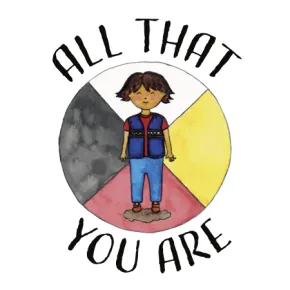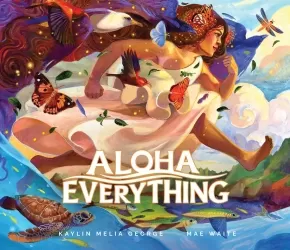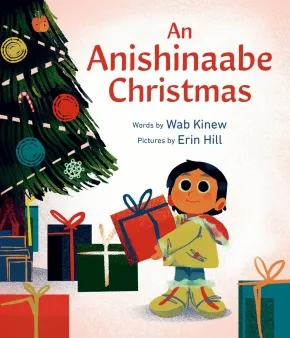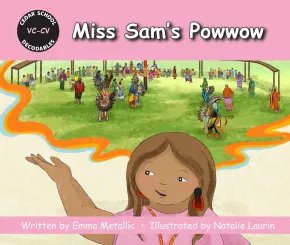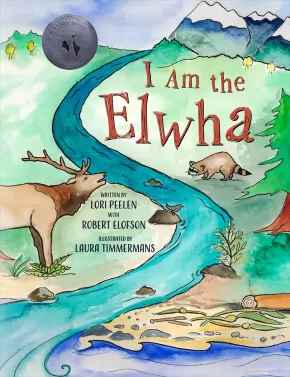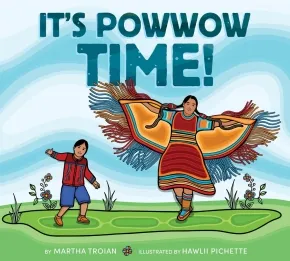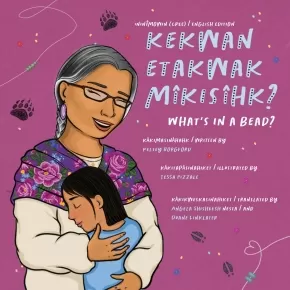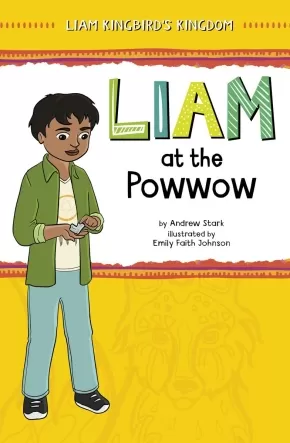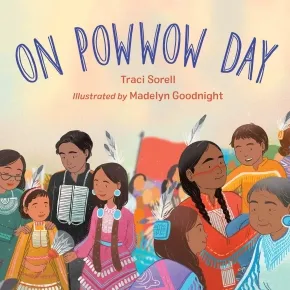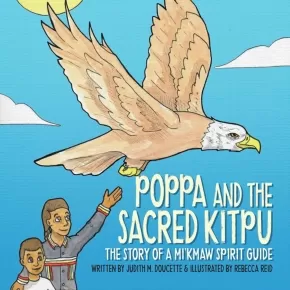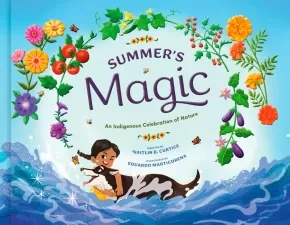
Indigenous Cultural Practices
31
-
45
of
205 Results;
Sort By
Go To
of 14
Wôpanâak Seasons: Seeqan, Neepun, Keepun, Pup8n
$24.95
Format:
Hardcover
Text Content Territories:
Indigenous American; Native American; Wampanoag (Wôpanâak);
Grade Levels: Preschool; Kindergarten;
ISBN / Barcode: 9781926890418
Synopsis:
Synopsis:
In Wôpanâak Seasons a young Wampanoag child takes readers on a seasonal journey through Aquinnah, on Neope, known as Martha’s Vineyard. Spring brings the return of wildlife; summer brings beach adventures and clambakes; fall is for harvesting cranberries and making jams; and winter features cozy gatherings and heartfelt traditions. Each season showcases the rich cultural heritage of the Wampanoag people. With striking illustrations and lyrical prose, this book is about an appreciation of the land and the joy the joy of coming together with our community all year round.
Educator Information
Recommended for ages 3 to 5.
Additional Information
40 pages | 7.00" x 8.50" | Hardcover
All That You Are Series Bundle
 $37.90
$37.90

Text Content Territories:
Indigenous Canadian; First Nations; Anishinaabeg;
ISBN / Barcode: 9781771746304
Synopsis:
Synopsis:
All That You Are is a series of heartwarming, affirmational picture books from author and illustrator Sarah-Anne Tourond.
Through lyrical text and watercolour illustrations, this series shares the teachings of the Anishinaabe Medicine Wheel to remind children of their connection to the world around them. Each book is inspired by one quadrant of the Medicine Wheel that represents an aspect of wellness—Spiritual, Physical, Emotional, or Mental. A diagram of the Medicine Wheel is included at the back of the books. Anishinaabe Connections are also included to share more about Anishinaabe art, culture, and traditions explored in the text and illustrations.
A percentage of proceeds from this series is donated to the Indian Residential School Survivors Society to support their efforts in advocacy for justice and healing. To find out more information, please visit https://www.irsss.ca/.
Books in the All That You Are Series include:
You Are Sacred – Connects to the Spiritual quadrant of the Medicine Wheel
You Are the Land – Connects to the Physical quadrant of the Medicine Wheel
Educator Information
Books in the All That You Are series are best suited for children ages 3 to 6 and make wonderful read-alouds in classrooms and homes.
Free lesson plans and activity sheets are available for each book.
Curriculum Connections:
Early Literacy – listening, reading, and discussing
Art – the rhythm and music of the world around us, traditional Anishinaabe clothing and art
Health and Wellness – focusing on breath and balance, self-affirmation
Science – harmonious ecosystems, biodiversity of plants and animals with Indigenous cultural importance, environmental awareness
Social Responsibility – uplifting others and ourselves
Indigenous Knowledge and Traditions – teachings of the Anishinaabe Medicine Wheel, the Seven Generations, and All Our Relations
Additional Information
Each book is 24 pages | 8” x 8” | Hardcover | Series ISBN: 978-1-77174-630-4
Aloha Everything
$30.50
Artists:
Format:
Hardcover
Text Content Territories:
Indigenous Hawaiian;
ISBN / Barcode: 9781636551128
Synopsis:
Synopsis:
Aloha Everything is a magical story that will take you on a thrilling journey through the breathtaking islands of Hawaiʻi!
In this exciting adventure, you'll encounter mighty canoes crashing over ocean waves, regal hawks soaring high above the clouds, and brilliant lizards jumping nimbly through forest trees! Most importantly, you'll meet a courageous young girl named Ano who learns, grows, and comes to love her island home with all her heart.
Since the day that Ano was born, her heart has been connected to her home. But, this adventurous child has a lot to learn! When Ano begins to dance hula — a storytelling dance form that carries the knowledge, history, and folklore of the Hawaiian people — Ano comes to understand the true meaning of aloha.
Aloha Everything is both a captivating read and a fantastic educational resource for learning about Hawaiian history, ecology, and culture. With breathtaking hand-painted illustrations and beautiful rhyming poetry that will lull little ones into brilliant dreams of vibrant adventure, this book is sure to capture the hearts of both children and parents alike.
The beautiful poetry—weaving its way through every page—artfully blends 25 Hawaiian words into the English prose and provides a thoughtful exploration of the meaning of aloha in relation to the land, the people, and the lore. There is also a pronunciation guide and glossary providing additional information for those looking to learn more about the rich language and culture of Hawai’i.
Reviews
"Mesmerizing, metered verse combines English and Hawaiian words for a rich tale of Hawaiian history, culture, ecology, and legends. Making deft use of light and shadow, the vibrant images bring the text to life... A stunning tribute to Hawaiian culture and identity."–starred review, Kirkus
"Lush illustrations by Waite and rhythmic quatrains by Melia George paint the story of a Hawaiian girl who learns about her cultural heritage through hula. . . . acrylic and gouache paintings linger on the eye in this gossamer work." –Publishers Weekly
Educator Information
Recommended for ages 5 to 8.
Additional Information
40 pages | 11.25" x 9.75" | Hardcover
An Anishinaabe Christmas
$24.99
Artists:
● Erin Hill (Indigenous;)
Format:
Hardcover
Text Content Territories:
Indigenous Canadian; First Nations; Anishinaabeg; Ojibway;
ISBN / Barcode: 9781774883570
Synopsis:
Synopsis:
A festive, joyful Indigenous picture book that explores both Christmas traditions and Anishinaabe culture, for fans of Santa in the City and Go Show the World.
One winter solstice, Mommy says, "Baby, we're going home to the Rez. We're going to have an Anishinaabe Christmas." But this is Baby's first Christmas away from the city, and they're worried! They have a lot of questions:
How will Santa know where to find them?
Why do we have presents on Christmas?
How come they're going home to the Rez but don't live there?
On the long trip to Mooshom's and Kookom's, Baby learns about animals being part of their family, about the North Star leading them home and even the meanings of some Anishinaabe words. Will this Anishinaabe Christmas be Baby's best yet?
Educator Information
Recommended for ages 3 to 7.
This book is available in French: Un Noël anichinabé
Additional Information
48 pages | 9.00" x 10.25" | Hardcover
Cedar School Decodables: Miss Sam’s Powwow
 $7.99
$7.99

Artists:
Format:
Paperback
Text Content Territories:
Indigenous Canadian; First Nations; Mi'kmaq (Mi'gmaq); Listuguj Mi'gmaq First Nation;
Grade Levels: Kindergarten; 1;
ISBN / Barcode: 9781771746489
Synopsis:
Synopsis:
In this story, Miss Sam talks to the class about powwows. Miss Sam has danced at powwows since she was a child.
Mi’gmaq gather with their community to dance and sing at powwows. This is also a time for healing and prayers.
What celebrations do you go to?
Educator Information
Recommended for ages 4-7, for use in kindergarten and Grade 1 classrooms.
Cedar School Decodables is divided into six sets, which increase in word count and complexity of sentence structure. Miss Sam’s Powwow is in Set 4 – Longer Words, and reviews closed/closed syllable words and compound words. Books in Set 4 have 90-100 words.
Readers should be familiar with the concepts included in Set 1 to Set 4:
- consonants
- beginning and end blends
- short and long vowels
- digraphs
- a /o/
- s – /s/ and /z/
- -s, -es, -ed, and -ing suffixes
- VC-CV, V/CV, VC/V, and compound words
- possessives
Series Information
Welcome to Cedar School! Join Liv, Tom, Gus, and Bell as they learn on the land and explore Mi’gmaw teachings with their teacher, Miss Sam, and the school’s Mi’gmaw Elder, Jen. With charming illustrations and simple storylines, this decodable series engages students as they practise their reading skills. Each book includes a pre-reading review of non-decodable words, and many of the books introduce special words related to Indigenous teachings. Talking Together prompts facilitate discussions led by the reading teacher.
Developed in partnership with Dyslexia Canada, Cedar School Decodables is a series of 20 decodable books for young readers. Designed for students who have previously learned short vowel and consonant sounds, additional phonic skills are developed progressively throughout the series.
The series will be accompanied by Cedar School Decodables Teacher’s Guide and a series of four picture books, which will be available at a later date.
This book is included in the Indigenous Books for Schools database from the Association of Book Publishers of BC. It is recommended for K to 2 classrooms for English Language Arts and Social Studies.
Additional Information
16 pages | 6.5” x 5.5” | Paperback | ISBN: 9781771746489
Cedar School Decodables: We Smudge
 $7.99
$7.99

Artists:
Format:
Paperback
Text Content Territories:
Indigenous Canadian; First Nations; Mi'kmaq (Mi'gmaq); Listuguj Mi'gmaq First Nation;
Grade Levels: Kindergarten; 1;
ISBN / Barcode: 9781771746502
Synopsis:
Synopsis:
In this story, Gus and Tom are upset. Miss Sam helps them smudge to feel better.
Mi’gmaq burn sage and other traditional medicines to smudge. Smudging helps people let go of sadness and anger.
What do you do when you are feeling sad?
Educator Information
Recommended for ages 4-7, for use in kindergarten and Grade 1 classrooms.
Cedar School Decodables is divided into six sets, which increase in word count and complexity of sentence structure. We Smudge is in Set 5 – Ending Spelling Patterns, and reviews -tch and -dge. Books in Set 5 have 100-110 words.
Readers should be familiar with the concepts included in Set 1 to Set 5:
- consonants
- beginning and end blends
- short and long vowels
- digraphs
- suffixes and ending spelling patterns
- a /o/
- s – /s/ and /z/
- VC-CV, V/CV, VC/V, and compound words
This book is included in the Indigenous Books for Schools database from the Association of Book Publishers of BC. It is recommended for K to 1 classrooms for English Language Arts and Social Studies.
Series Information
Welcome to Cedar School! Join Liv, Tom, Gus, and Bell as they learn on the land and explore Mi’gmaw teachings with their teacher, Miss Sam, and the school’s Mi’gmaw Elder, Jen. With charming illustrations and simple storylines, this decodable series engages students as they practise their reading skills. Each book includes a pre-reading review of non-decodable words, and many of the books introduce special words related to Indigenous teachings. Talking Together prompts facilitate discussions led by the reading teacher.
Developed in partnership with Dyslexia Canada, Cedar School Decodables is a series of 20 decodable books for young readers. Designed for students who have previously learned short vowel and consonant sounds, additional phonic skills are developed progressively throughout the series.
The series will be accompanied by Cedar School Decodables Teacher’s Guide and a series of four picture books, which will be available at a later date.
Additional Information
16 pages | 6.5” x 5.5” | Paperback | ISBN: 9781771746502
Discovering and Understanding The Métis
$24.99
Format:
Hardcover
Text Content Territories:
Indigenous Canadian; Métis;
ISBN / Barcode: 9782898244766
Synopsis:
Synopsis:
From their origins to their lives today, the Métis have so many things to tell us! Thanks to beautiful photos, illustrations, and texts written by experts, we can learn and understand more about the rich culture of the Métis.
Educator & Series Information
Recommended for ages 7 to 12.
This book is part of the Discovering and Understanding series.
Additional Information
32 pages | 8.66" x 10.62" | Hardcover
I Am the Elwha (PB)
 $14.95
$14.95

Artists:
Format:
Paperback
Text Content Territories:
Indigenous American; Native American; Salish; Coast Salish; Klallam (Clallam); Lower Elwha Klallam Tribe;
ISBN / Barcode: 9781771746311
Synopsis:
Synopsis:
"I am the Elwha, rushing down to the sea. I am the Elwha, wild and free."
The Elwha River flows 72km (45 miles) from its source in the Olympic Mountains to the Strait of Juan de Fuca in the Pacific Northwest. Uniquely, it hosts all six salmon species (Pink, Chinook, Coho, Sockeye, Steelhead, and Chum) as well as several species of trout.
In 1911, two dams were built on the river. The dams blocked the migration routes of the salmon and dramatically altered the entire river ecosystem for 100 years. In 2012, the dams were decommissioned and the world's largest dam removal and habitat restoration project began. In this lyrical and beautifully illustrated book, the author chronicles the history of the Elwha.
Narrated by the powerful voices of plants and animals that inhabit the river ecosystem, the dam builder, a worker, members of the Klallam Tribe, and the river itself, this story celebrates the ongoing rewilding of this special environment and offers a welcome to all the creatures who are coming home.
To learn more visit: www.elwha.org
Awards
- 2021 Riverby Award for Young Readers
Reviews
“I Am the Elwha is a powerful read about a powerful river and those who value and protect it." – Raina Delisle, Hakai Magazine
Educator Information
Recommended for grades 3 to 7.
At the back of the book are three pages of cultural, scientific, and historical information that discuss the following:
- the importance and symbolism of salmon to the Lower Elwha Klallam Tribe and other Coastal Salish Tribes
- facts about the six species of salmon found in the Elwha River (Chinook, Pink, Chum, Sockeye, Coho, and Steelhead)
- the history of the Elwha River and its status today
Keywords / Subjects: The Elwha River, Rivers, Dams, History, Environmental Awareness, Lower Elwha Klallam Tribe, Coast Salish, Native American, Culture, Washington, Animals, Salmon, First Salmon Ceremony, Plants, Nature, Settlers, Social Responsibility, Environmental Activism, Poetry.
Additional Information
32 Pages | 8.5" x 11" | ISBN: 9781771746311 | Second Edition | Paperback
Authenticity Note: This lyrical story, which chronicles the history of the Elwha River, is written by Lori Peelen. Robert Elofson, Tribal Elder and Harvest Manager in the Natural Resources Department for the Lower Elwha Klallam Tribes, approved Lori's work and contributed pages of back matter at the end of the work. Lori's story was further approved by Frances Charles, the Tribal Councilwoman for the Lower Elwha Klallam Tribe, after the entire council read and approved it.
The Canadian Content label has been applied because the illustrator of this work is Canadian.
It's Powwow Time!
$24.99
Artists:
Format:
Hardcover
Text Content Territories:
Indigenous Canadian; First Nations;
ISBN / Barcode: 9780063116665
Synopsis:
Synopsis:
This lyrical and joyful picture book celebrates new experiences and community traditions when a young boy learns to dance at his first powwow. It’s Powwow Time! is for readers of Cynthia Leitich Smith’s Jingle Dancer and Oge Mora’s Thank You, Omu!
Bineshii is looking forward to his first powwow. He wakes up and travels with his mother to the community event. He eats bannock and drinks strawberry juice as he watches the dancers perform. And ever so slowly, Bineshii works his way from the edge of the circle watching the dancers to inside the circle itself, dancing and celebrating with everyone else.
Award-winning journalist Martha Troian’s child-centered text and Hawlii Pichette’s action-packed illustrations build excitement on the page as Bineshii’s curiosity and confidence grows. It’s Powwow Time! explores the rewards of being open to new experiences while also serving as a beautiful and informative introduction to a First Nations powwow.
Educator Information
Recommended for ages 4 to 8.
Keywords/Themes: Early Years (Body and the Senses); Powwows; Self-Esteem; Dance; New Experiences.
This book is a wonderful read-aloud.
Includes an author's note about powwows.
Additional Information
32 pages | 10.00" x 9.00"
kekwan etakwak mîkisîhk / What’s in a Bead?
$21.95
Artists:
Format:
Hardcover
Text Content Territories:
Indigenous Canadian; First Nations; Anishinaabeg; Cree (Nehiyawak);
ISBN / Barcode: 9781772603675
Synopsis:
Synopsis:
There are many stories in a bead. We must listen to the stories they tell us.
Tessa loves how her grandmother always smells of campfire stories. Mom says it’s because Kohkom spends her days sewing beautiful beads onto smoked hides. Inspired, Tessa asks Kohkom to teach her beading, but first she must listen and learn about the many stories held in a bead.
A celebration of Cree craftsmanship, language, and learning. The loving exchange of knowledge between Tessa and her Kohkom will be familiar to many children. Readers will learn that different Indigenous communities have different beadwork techniques, and that this traditional art form is alive and thriving today.
Reviews
"The story is a beautiful look into the importance of beading in our communities and the ways that this art practice ties us together as families and communities." — Nancy Cooper, First Nations Consultant for the Southern Ontario Library Services and coordinator for First Nation Communities Read
Educator Information
Recommended for ages 6 to 8.
This dual language edition contains the story in both Ininîmowin (Cree, N-dialect) and English.
Translators: Duane Linklater & Angela Shisheesh
Duane is Omaskêko Ininiwak and currently lives in North Bay, Ontario. He earned a Master of Fine Arts from Bard College and a Bachelor of Native Studies with a focus in Cree language from the University of Alberta. Linklater is lifelong learner of the Cree language and credits the many Elders, including his kohkom Agnes Hunter, for teaching and sharing the language.
Angela is a Cree translator at Ojibway & Cree Cultural Centre based in Timmins, Ontario
An English-only version is available: What's in a Bead?
This book is available in French: Le pouvoir d'une perle
Additional Information
24 pages | 8.50" x 8.50" | Hardcover
Liam at the Powwow
$10.99
Format:
Paperback
Text Content Territories:
Indigenous American; Native American; Anishinaabeg; Ojibwe (Chippewa);
ISBN / Barcode: 9781484689042
Synopsis:
Synopsis:
Eight-year-old Liam attends a local powwow despite his anxieties in this installment from Liam Kingbird’s Kingdom.
Young Liam Kingbird, a shy boy from an Ojibwa reservation, is nervous about attending a nearby powwow with his best friend, Zach. However, Liam soon discovers that the crowded venue is full of magic too—from delicious Indian Tacos to lively drum circles. Can Liam overcome his anxiety and enjoy this celebration of his culture? Find out in this installment of the popular Liam Kingbird’s Kingdom chapter book series by Ojibwa author Andrew Stark.
With achievable text and colorful illustrations, all books in the Liam Kingbird’s Kingdom series are perfect for early readers, grades K–3.
Educator & Series Information
Say boozhoo (hello) to Liam Kingbird! Liam is eight years old and lives on an Ojibwa reservation. Quiet, creative Liam is a thinker, a dreamer . . . and sometimes a worrier. New experiences can be scary for Liam, but talking with his mom, drawing pictures, and listening to his heart always steer him in the right direction. Featuring an introspective Indigenous boy with a cleft lip and a beautiful spirit, this charming chapter book series for K–3 will resonate with readers who like to think before they leap.
With achievable text and colorful illustrations, all books in the Liam Kingbird’s Kingdom chapter book series are perfect for early readers, grades K–3.
Genre: Realistic Fiction
Additional Information
32 pages | 6.00" x 9.00" | Paperback
On Powwow Day (BB)
$10.99
Artists:
Format:
Board Book
Text Content Territories:
Indigenous American; Native American; Cherokee; Cherokee Nation (Cherokee Nation of Oklahoma);
Grade Levels: Preschool;
ISBN / Barcode: 9781623545765
Synopsis:
Synopsis:
In this board book by best-selling Native author Traci Sorell, discover colors, sounds, and counting from one to ten on powwow day!
This eye-catching, interactive board book is sure to keep toddlers engaged. Count one through ten as you make your way through the day of the powwow, looking for colors, family members, jingle dresses, musical instruments, and tribal citizens in this introduction to a traditional Native event.
An award-winning children's picture book adapted to be ready for little listeners in a warm and vibrant board book edition.
Reviews
"A colorful counting book engages children to identify the different visual elements that occur on powwow day. From the car that vrooms to the shaking shiny jingle cones, the exciting expressions catch more beyond the eye. The rainbow palette is shown off in organic and youthful design work. Every number from one to ten has a corresponding color, attached to a powwow day element. Readers can identify and count these elements, from the gray feathers on regalia to the bright moccasins. VERDICT This delightful picture book allows Indigenous children to connect with and feel pride in the abundance of powwow participation, and gives all readers a great counting book full of cultural imagery."—School Library Journal, starred review
Educator Information
Recommended for ages 3 and under.
Additional Information
20 pages | 5.88" x 5.88" | Board Book
Poppa and the Sacred Kitpu
$18.95
Artists:
Format:
Paperback
Text Content Territories:
Indigenous Canadian; First Nations; Mi'kmaq;
ISBN / Barcode: 9781774571859
Synopsis:
Synopsis:
After being invited into his grandson’s school to share his wisdom and knowledge of his traditional Mi’kmaw culture in Poppa and His Drum, Poppa is happy to return as a respected Indigenous Elder and Knowledge Keeper.
In this second book of the Poppa series, we find Poppa giving his next gin’masuti (lesson in our culture) to his grandson, François, and his friends, Paul and Joe.
The boys have an important art project to complete for school and are not sure what to do. While spending the afternoon on a beach adventure with Poppa, the boys get to learn about the Sacred Kitpu (Bald Eagle) and why it’s so important to our Indigenous People.
Poppa engages the children with eager imaginations of how the Sacred Kitpu is not only a powerful spirit guide, but also represents the Spirit of the Creator among us. It is the messenger between Mother Earth and the Spirit World, whispering to the Creator our prayers, touching the face of the Creator with its wing.
Poppa teaches the children through mystic wonder how we use the Sacred Kitpu feather in many different cultural ceremonies. He embraces their eagerness to learn and shares the tradition of smudging, using the Kitpu feather along with Sacred Medicines that burn in a smudge bowl to purify our body, mind, and spirit.
The children delight in discovering Poppa’s never-spoken-of regalia treasures that once belonged to his grandfather and decide to commemorate their art project to the Sacred Kitpu.
Poppa is invited back to the class to award the winning medal to the winners of the arts project. He is proud to present the medals to happy children who truly understand and appreciate the importance of the role the Sacred Kitpu plays in our Mi’kmaw culture and heritage. Poppa and the Sacred Kitpu will delight and surprise the reader with fun and teachings given by the love of a Poppa who is cherished by his community for being such a wonderful Mi’kmaw Elder.
Educator & Series Information
Recommended for ages 5 to 12.
This book is the second book in the Poppa series, following Poppa and His Drum.
Additional Information
9.00" x 9.00" | Paperback
Stitches of Tradition (Gashkigwaaso Tradition)
$24.99
Format:
Hardcover
ISBN / Barcode: 9780063218680
Synopsis:
Synopsis:
“Noozhishenh, bimadiziwin,” Nookomis says. “My granddaughter, live a good life.”
An Ojibwe grandmother carefully measures and selects just the right colors of fabric, and her sewing machine hums whirr, whirr, whirr late into the night.
In the morning, her growing granddaughter has a beautiful new ribbon skirt to wear, a reminder of her nookomis and the cultural traditions that stitch together her family with love.
This heartwarming story by Marcie Rendon (Ojibwe), with stunning illustrations by Joshua Mangeshig Pawis-Steckley (Ojibwe), celebrates the power of Indigenous craft and community and weaves together the spirit of resilience, female empowerment, and gratitude for the generations that came before us.
Reviews
A radiant and joyful glimpse at an important Native tradition." — Kirkus Reviews (starred review)
"Tradition and love are the core of this picture book...Ojibwe language is seamlessly woven into the dialogue. The digital art fully saturates the pages, layering textures and colors much like the ribbon skirts, and the palette is buoyant and bright, exuding a celebratory feel." — Bulletin of the Center for Children’s Book"s
Educator Information
Recommended for ages 4 to 8.
Detailed text perfect for read-alouds.
Backmatter includes a glossary of Ojibwa terms, more information on ribbon skirts, including history and significance, and infromation about manoomin (wild rice).
Additional Information
40 pages | 8.50" x 11.00" | Hardcover
Summer's Magic
$19.99
Artists:
Format:
Hardcover
Text Content Territories:
Indigenous American; Native American; Anishinaabeg; Potawatomi;
ISBN / Barcode: 9780593577837
Synopsis:
Synopsis:
An Indigenous boy invites new friends to share in beloved traditions as he celebrates the joy of summer and his love for Earth and Creator in this picture book that revels in the warmth, light, and fun of the longest days of the year.
Bo, a proud Potawatomi boy, is excited to enjoy long summer days tending his garden, walking his dog, and playing in the river with his big sister, Dani. When he discovers that his family's favorite spot has been polluted with garbage, Bo realizes that caring for Earth is part of what makes summer special. And when he overcomes his shyness and invites others to join in, he discovers that summer's magic has even more surprises in store.
“Bo is short for saying Bodewadmi ndaw, which is ‘I am Potawatomi’ in our language. Bo is a celebration of Anishinaabe culture, from the way he wears his hair in a traditional braid to the way he shares the magic of summer and honors Earth by caring for her as she cares for us.”—Kaitlin B. Curtice
Educator & Series Information
Recommended for ages 3 to 7.
This book is part of the An Indigenous Celebration of Nature series.
Additional Information
40 pages | 11.00" x 8.50" | Hardcover
Sort By
Go To
of 14




